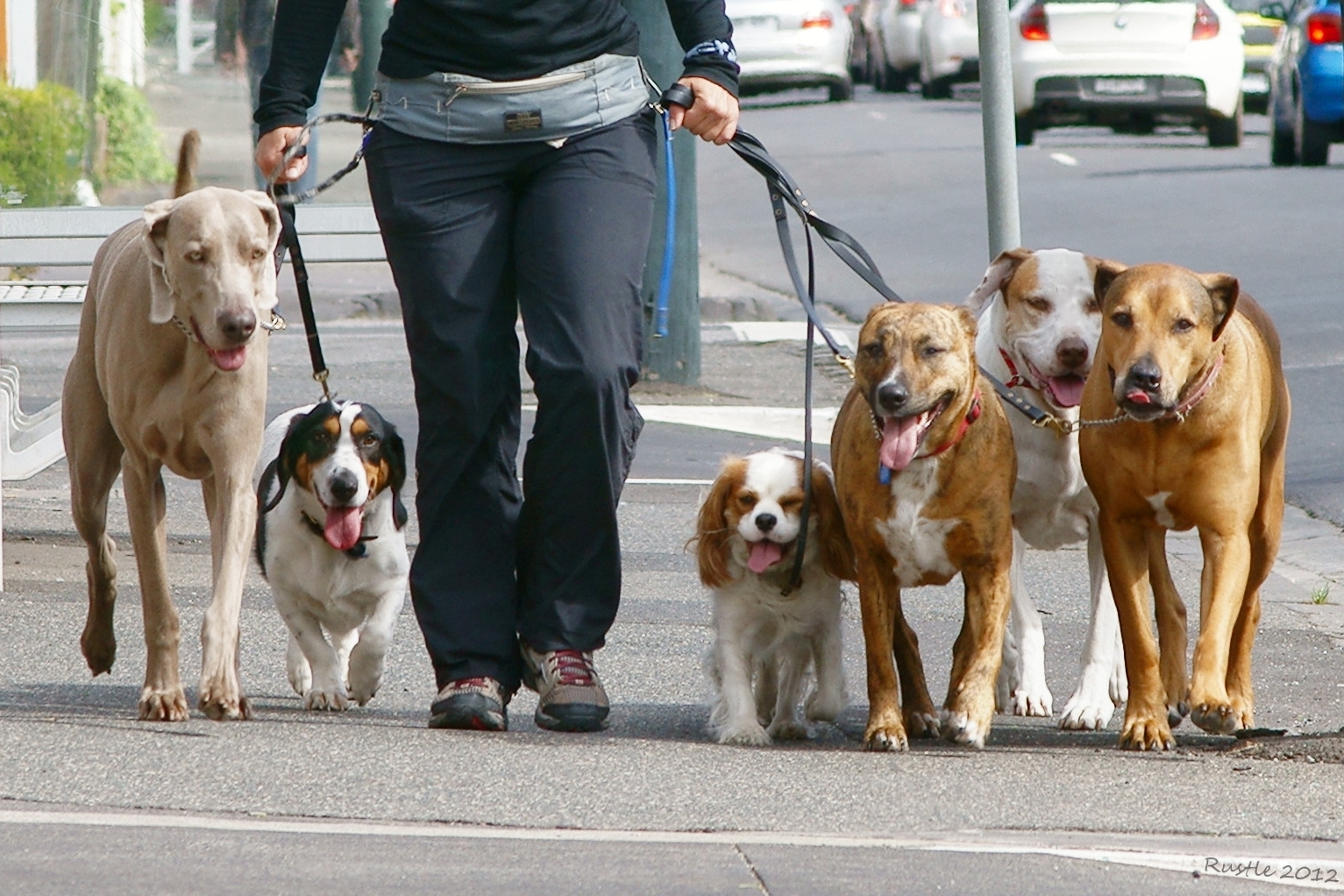
Image source: https://mypuppylove123.files.wordpress.com/2013/01/dogwalker.jpg
Walking your dog can be a great experience for both of you and your dog. Even if the weather that day isn't perfect, most dogs are so enthusiastic about going out for a walk that it's hard not to get at least a little excited about going out with them and exploring the great outdoors. The only problem is that walking next to their owners outside is not natural for any dog. So if you have a new puppy or a dog that has never learned to let you control the walk, I hope I have some useful information here for you.
Why go through the effort to train your dog to walk with you? Well, if you have a medium or large dog that pulls towards every smell, every squirrel, or every other dog, I think you already know the answer to this question. Under these conditions, walking with even the most loving dog on the most glorious spring day can become a chore, or even painful. But even if we don't consider extreme cases, a dog walking properly next to you has many other benefits. First, if he is allowed to walk in front of you he is less aware of what pace and direction you are moving. No wonder you have to tug on the leash to get him to turn those corners! Also, if you have a dog or puppy that wants to eat anything that smells good that he comes across, how can you intercede if you are way behind him? Finally, there are many trainers that feel that dogs will naturally become the "pack leader" if they sense nobody else is filling that role. Many of these trainers are quick to point out that most dogs don't WANT to be the pack leader. They would be less anxious and more relaxed to let someone else run the show, but in the wild, the pack will only survive if there is a leader, so they instinctively try to step up to the job. This means if you are not the leading the walk, your dog will lead the walk. Which probably sounds okay until the pulling starts.
As we begin our journey to good dog walking, let's start with the basics; the collar or harness. If you already know that your dog is a strong puller, a standard collar and leash may not prevent him from injuring himself. Alternatives such as front-attaching harnesses or a "halti" type collar should be used. Choke or prong collars are available, however these can cause injury and really don't teach your dog how to walk properly.
If you have a puppy or an active dog, it seems natural to get him outside on a walk right away to burn off some of that energy. However, many trainers advocate building up to the outdoor walk, so we don't have to fight bad habits immediately. Start by introducing your dog to the leash in a positive way in a location without distractions, such as in your home.
Some dogs will be so excited about their walk that you get pulled out the door and it never stops. If you find this seems to be the case, don't just plunge ahead only to be disappointed with your dog's walking skills. This is a case where a little desensitization can help a lot. Begin taking the leash out several times a day and then don't walk him. The idea is for him to begin to realize that the leash doesn't always mean it's time to go outside. Taking your dog outside to play in the backyard BEFORE the walk also helps in these cases.
Start off by taking a short walk following a straight path, rewarding eye contact. Change directions more frequently as your dog gets the feel for it. Use treats in a productive manner. Some dogs will be so excited once they are walking outside that they won't seem to be interested in treats (or you), so right from the start, practice calling your dog's name and then giving him a treat when he responds with eye contact. Other dogs love their treats so much that just giving them one treat seems to make them almost lose interest in the walk as they start looking for the next snack. Begin your introduction to the walk indoors, then your backyard and then the sidewalk in front of your house.
There are different methods for dealing with the inevitable leashing pulling that you will experience, but the most recommended method is to simply stop walking when there is tension on the leash. Your dog is excited about something ahead and he really doesn't mind dragging you along if it means he can get to what is so interesting. Simply put, don't reward pulling by allowing your dog to get to his goal by pulling you along and you should be consistent about it. Sometimes simply stopping will be enough to make your dog curious about what happened to you and he will look back or even walk back to you, which is great. Even though this outcome is positive and you should encourage and reward it, you may have to take a more proactive response, namely gently but firmly reversing direction after a verbal signal ("let's go" or something along those lines). Also, if your dog has begun to associate you calling his name with him getting a treat, simply calling him may do the trick.
During the learning period, expect to be reversing direction pretty frequently. Don't be discouraged by unfulfilled expectations that you cover a certain route. Judge your success on a minute by minute basis. If your dog is not pulling, you are setting up a walking behavior that will benefit you for years to come. This is true even if you have some 20 or 30 minute walks but never get more than a few houses away from home as a result of you are reversing direction so frequently. Finally, try to allow extra time for your walks. You won't be able to guide your dog through his correct walking manners if you need to be rushing back home.
As your dog learns how to walk with you without pulling, you will find that not only are you both getting exercise and fresh air, but you are walking together as a team, which is a pretty great experience for any dog owner.
